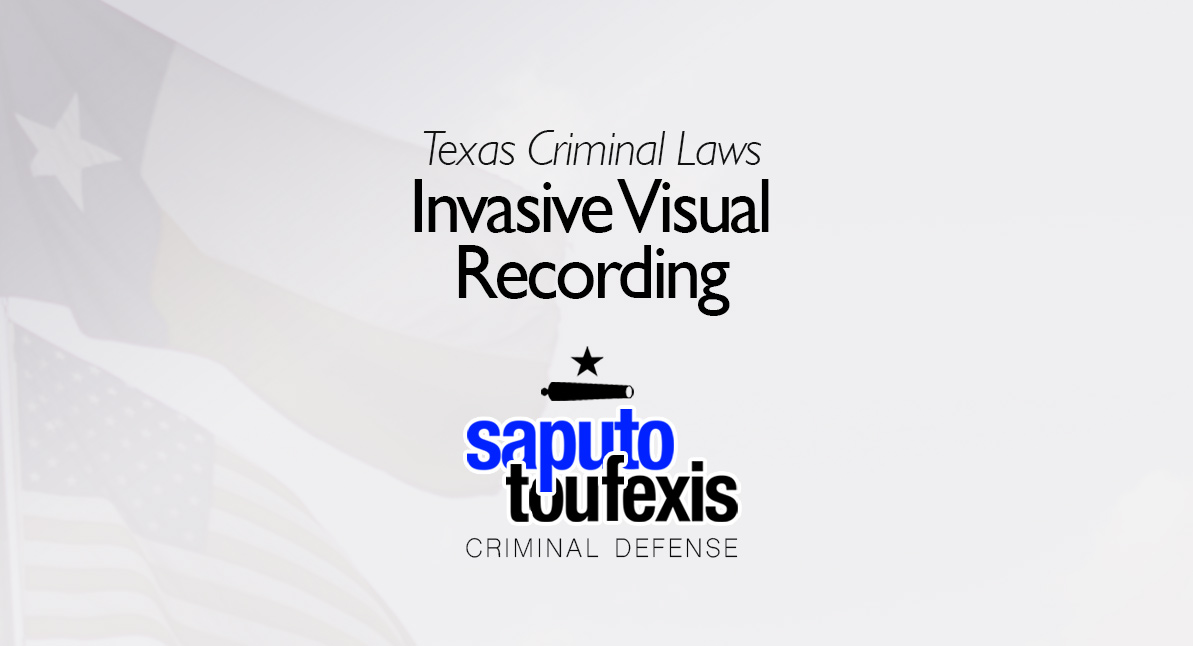The Texas Invasive Visual Recording law gives police the right to arrest you if they believe you took, or helped spread, any kind of photograph or video of (1) someone’s “intimate areas” or (2) someone in a bathroom or changing room.
FAQs about the
Invasive Visual Recording law in Texas
- What is the current Texas law about Invasive Visual Recording?
- How can I be charged with an Invasive Visual Recording offense in Texas?
- What is the statute of limitation for Invasive Visual Recording in Texas?
- What is the penalty for a Texas Invasive Visual Recording offense?
- Can you get probation for Invasive Visual Recording in Texas?
- Do I have to register as a sex offender in Texas if guilty of Invasive Visual Recording?
- What level of crime is Invasive Visual Recording in Texas?
Originally called Improper Photography or Visual Recording, this law was updated in 2015 and renamed. For years, lawyers had argued that the original statute was overly broad and unconstitutional. In response, the Texas Court of Criminal Appeals invalidated the statute.
Have you been charged with Invasive Visual Recording? Contact us today to discuss legal representation.
or Text or Call (888) 239-9305
The legislature responded by passing the new law, now known as the Texas Invasive Visual Recording law. We have primarily seen this law, often called the “upskirt law,” prosecuted most often in cases involving hidden cameras in bathrooms and changing areas. Hidden camera cases often hinge on extablishing a link between the camera and the person accused of putting it there.
The current Invasive Visual Recording law differs from the previous statute in that it does not require prosecutors to establish that the defendant intended to arouse or gratify sexual desires. This change simplifies the process for the District Attorney to secure convictions. This offense is now known as the “peeping Tom” or “creeping” crime.
The Texas legislature codified this criminal offense in Texas Penal Code Section 21.15. The law was not updated in 2023. In fact, this law has not been amended since it was renamed in 2015.
The Penal Code classifies the Texas Invasive Visual Recording law under Title 5 “Offenses Against the Person,” Chapter 21 “Sexual Offenses.” Learn more about the Texas offense of Invasive Visual Recording below.
What is the current Texas law about Invasive Visual Recording?
Texas law currently defines the offense of Invasive Visual Recording in Penal Code Section §21.15 as follows:[1]
(b) A person commits an offense if, without the other person’s consent and with intent to invade the privacy of the other person, the person:
(1) photographs or by videotape or other electronic means records, broadcasts, or transmits a visual image of an intimate area of another person if the other person has a reasonable expectation that the intimate area is not subject to public view;
(2) photographs or by videotape or other electronic means records, broadcasts, or transmits a visual image of another in a bathroom or changing room; or
(3) knowing the character and content of the photograph, recording, broadcast, or transmission, promotes a photograph, recording, broadcast, or transmission described by Subdivision (1) or (2).
The 84th Texas Legislature significantly amended this law in response to Ex parte Thompson.[2] In that case, the Texas Court of Criminal Appeals struck down a law called Improper Photography or Visual Recording as substantially overbroad.[3] The legislature amended the Improper Photography or Visual Recording law and retitled it Invasive Visual Recording.[4]
Definition of intimate area
The new law defines Intimate area for the purposes of this subsection as “the naked or clothed genitals, pubic area, anus, buttocks, or female breast of a person”[5] “Female breast” is defined in this subsection as “any portion of the female breast below the top of the areola.”[6]
Definition of Changing Room
Changing room is defined in this subsection as “a room or portioned area provided for or primarily used for the changing of clothing and includes dressing rooms, locker rooms, and swimwear changing areas”[7]
Definition of Promotes
Promotes is defined in this subsection as “to manufacture, issue, sell, give, provide, lend, mail, deliver, transfer, transmit, publish, distribute, circulate, disseminate, present, exhibit, or advertise, or to offer or agree to do the same”[8]
How can I be charged with an Invasive Visual Recording offense in Texas?
You can be charged with Invasive Visual Recording in Texas if the state’s attorneys believe that each of the elements of 21.15(b) as described in the section above have been met.
The state’s attorneys can use your cell phone or camera against you, and they can obtain internet records that can provide information related to the use of virtually any device connected to the internet. Also, an accuser can simply tell the police that you were involved in the taking of the pictures or video, and then the prosecuting attorneys can demand that the person testifies against you.
What is the statute of limitation for Invasive Visual Recording in Texas?
Invasive Visual Recording offenses have a three-year limitations period.[9]
What is the penalty for a Texas Invasive Visual Recording offense?
A conviction for Invasive Visual Recording in Texas is punished as a state jail felony,[10] with a maximum possible fine under Texas state law of up to $10,000 and jail time of up to two years.
But do you have to register as a sex offender if you’re convicted of Invasive Visual Recording?
Can you get probation for Invasive Visual Recording in Texas?
The Texas Code of Criminal Procedure allows both judges and juries to grant probation for Invasive Visual Recording, and judges are also allowed to accept deferred adjudication plea deals.[11]
Note, however, that no matter the offense, neither judges nor juries may recommend community supervision for any suspended sentence of over 10 years.[12] Also, judges may not grant community supervision after a conviction if (1) the defendant used or exhibited a deadly weapon during the commission of the felony or immediate flight thereafter and (2) the defendant used or exhibited the deadly weapon himself or was a party to the offense and knew that a deadly weapon would be used or exhibited.[13]
Do I have to register as a sex offender in Texas if guilty of Invasive Visual Recording?
The Invasive Visual Recording offense does not appear on the list of offenses requiring registration under Chapter 62 of the Texas Code of Criminal Procedure.[14]
However, the legislature can add this offense to the list at any time. If that happens, people convicted of Invasive Visual Recording would have to register, even if the offense did not appear on the list at the time they accepted a deferred adjudication plea (even if later dismissed), pled guilty or were founty guilty.
What level of crime is Invasive Visual Recording in Texas?
The Penal Code classifies the punishment for Invasive Visual Recording as a state jail felony.
Learn more about the penalty range for this offense in the section above.
Legal References:
^1. Texas Penal Code §21.15. This law is current as of 2024.^2. Ex parte Thompson, 442 S.W.3d 325 (Tex. Crim. App. 2014)^3. See “Texas’ highest criminal court strikes down ‘improper photography’ statute” by the Washington Post^4. Senate Bill 1317, 84th Texas Legislature^5. -3503-48c7-934a-7b9da8118ddc&coa=coscca&DT=OPINION&MediaID=fa16d354-fe1a-47df-a3bd-fff85d0dddc1″ target=”_blank” rel=”noopener noreferrer”>Ex parte Thompson, 442 S.W.3d 325 (Tex. Crim. App. 2014)^6. Texas Penal Code §21.15(a)(1)^7. Texas Penal Code §21.15(a)(3)^8. 5d0dddc1″ target=”_blank” rel=”noopener noreferrer”>Ex parte Thompson, 442 S.W.3d 325 (Tex. Crim. App. 2014)^9. See Code of Criminal Procedure 12.01(9)^10. Texas Penal Code §21.15(c)^11. See Chapter 42, Texas Code of Criminal Procedure, Art. 42A.054, Art. 42A.056, Art. 42A.102^12 Art. 42A.053(c), Texas Code of Criminal Procedure^13. Art. 42A.054(b), Texas Code of Criminal Procedure^14. Code of Criminal Procedure, Article 62.001










